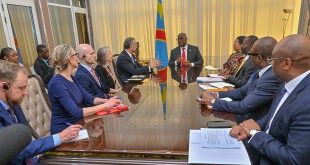
By Patrick Matsiko wa Mucoori
Whatever clucks and walks like a duck is always a duck even by another name. No matter whether the UPDF calls itself a disciplined pro-people’s army or defender of human rights, it will always be more known by its actions than its words.
In April this year the Human Rights Watch (HRW) released its 2009 report containing 106 torture cases between August 2008 and February 2009 (in just six months) by the Joint Anti-Terrorism Taskforce (JATT) whose command is drawn from the Chieftaincy of Military Intelligence (CMI). The report details how civilians were illegally detained and tortured in ‘safe houses’ (illegal state torture chambers). Some of them were killed, some lost limbs or were deformed and others are still unaccounted for.
In the government-owned New Vision of May 1 this year, the army spokesman Major Felix Kulayigye wrote refuting the accusations and said it would be ‘foolhardy for the UPDF whose strength rests on discipline and respect for human rights to be the same to violate these rights.’ He said soldiers who have committed gross crimes against civilians in the past have been executed by firing squad. He said the NRM/A ‘revolution’ was premised on resisting and stamping out (not even just reducing) state-inspired human rights violations by security agencies during the ‘Milton Obote and Idi Amin dictatorial regimes.’

He argues that therefore when HWR says JATT committed human rights abuses against civilians, it means their researchers did a poor investigation. Amusingly, Kulayigye justifies detention of civilians in ‘safe houses’ saying the detainees are hardcore terror suspects and government lacks enough gazetted prisons.
Former detainees interviewed by HRW named Lt. John Mwesigwa; Pte. Mushabe; Lt. Asiimwe Semakula; 2nd Lt. Barigye alias Cool Namara; Robert Namara; Mucunguzi Abdul Azziz alias Mucunguzi Deo; Lt. Sendi Yahya; Sankara alias Amiir; Kigoonya Siraje and one Opio as CMI/JATT’s lead torturers.
In his brief to the HRW, the Chief of Military Intelligence Brig. James Mugira confirmed that Sendi Yahaya, Kigonya Siraji, Mucunguzi and Sankara alias Amir (all former ADF rebels), Lt. John Mwesigwa and Lt. Robert Namara Cool are JATT/CMI officers or agents. He said he did not know Pte. Mushabe, Lt. Asiimwe and 2nd Lt. Barigye.
President Museveni and the UPDF leadership have repeatedly said such soldiers would not escape execution by firing squad. So what has happened to the firing squad this time? Why hasn’t the UPDF ordered any investigations against their officers named in the torture?
Brig. Mugira told The Independent that he needs hard evidence before he can order investigations but that the HRW refused to bring him the complainants to pin the accused soldiers. ‘I want to see the complainant first. If the complainant is not disclosed, how do I investigate?’ he asked.
The government has blacklisted ADF a terrorist group. So why does CMI employ the ADF ‘terrorists’ to terrorise suspects?
‘I don’t think they were involved [in torture] because they are not part of the interrogation team. We integrated them like we have been doing with other former rebels, but we don’t use them for interrogation because they don’t have the skills,’ Mugira says.

He claimed they are only used in identifying their fellow former rebels and for that reason they are always a target by the ADF who think they have betrayed them. He said they could have been framed by arrested ADF rebels in order to have them punished. He cited several former rebels who were killed by ADF after renouncing rebellion.
The Executive Director of Human Rights Initiative, Livingstone Sewanyana, alludes to the same argument that CMI could be using former ADF under the same pretext cited during the Operation Wembley that the best people to catch the robbers were fellow former criminals. However he adds that the government could also be sending a clear message to whoever engages in crime to be aware of the ultimate price. ‘We should be fighting this impunity,’ he said.
During the Amin/Obote regimes people were tortured and killed in Nakasero and Nile Mansions. Today the torture dungeons have shifted address to Kitante and Kololo. What is common among them all (Obote, Amin and Museveni regimes) is the belief that the tortured are hardcore criminals who do not deserve trial in courts of law.
The Obote security chiefs killed people like Rwancwende and Mbiringi in Mbarara, Luttamaguzi in Luweero saying they were hardcore rebel collaborators. Amin killed Archbishop Luwum and Ben Kiwanuka on similar accusations. During the NRM regime, Patrick Mamenero and several others have been killed at CMI on similar accusations. Given the foregoing, none of the three regimes has moral ground to condemn the other for extrajudicial killings.
In its torture series last year, The Independent reported an incident where one Ronald Kasekende fell in the compound of the Danish ambassador’s residence in Kitante as he fled from CMI dungeons next door. His pursuers recaptured him. His fate is unknown.
Diplomats who live in Kololo told human rights activists that they often heard screams of pain from the JATT chambers in the area.
In or about October 2007, Hanifa Nalukwago was arrested by JATT for alleged subversion. She was released on February 24, 2008 without a charge. Issa Wazemba, a dealer in second-hand clothes was arrested in Jinja by security operatives in November 2007 as he returned from a shopping trip in Kampala. He was tortured at Kololo and Kitante and released late 2008 without any case to answer. But he had lost a leg and his manhood due to torture. He is now impotent.
Saidi Lutaaya, a hawker, was arrested by JATT on November 22, 2007 from Old Taxi Park in Kampala. Two days later, his body was found at Mulago Hospital mortuary. When his family came to collect the body, they were told that soldiers had taken it away. Apparently Lutaaya was alive when soldiers brought him to Mulago. He had a hole in his foot and the bone of his lower leg was sticking out. He had been hit in the head and blood was oozing out. He was registered as Sgt. Lutaaya. Friends and family continued to search for his body until his wife was advised not to give more money to conmen claiming to know Lutaaya’s whereabouts. His body has never been seen.
Tayebwa Yassin alias Hamza Kaifa was arrested by JATT, charged with terrorism and sent to Luzira prison in April 2008. He died on June 9, 2008 at Mulago. The cause of his death is not known but former detainees from the Kololo ‘safe house’ told HRW that he had been beaten so badly by JATT operatives that he could not walk.
Isa ‘Drago’ Kiggundu was arrested on May 15, 2000 for alleged terrorism. He was paraded before the press at Makindye military barracks on June 24, 2000 and subsequently charged. He stayed in detention in Mbuya army barracks and later Kigo prison until his release in 2006. On October 18, 2007, Kiggundu was home with his family, four cars with armed men in civilian clothes came. One of them started firing into the house. Kiggundu emerged holding his baby daughter. He was killed in the barrage of bullets. Shortly after, the UPDF announced in a press statement: ‘An ADF terrorist, Drago Kiggundu, alias ‘Moses,’ ‘Muhammed,’ ‘Dan’ was this afternoon of 18th October 2007 put out of action by the UPDF Joint Anti Terrorism troops in Wakiso Town…’
Abdu Semugenyi was electrocuted by JATT in Kololo in April 2006 for being an ADF rebel. One of the detainees told HRW: ‘I saw Semugenyi before he died. One night, JATT agents brought two men outside near where I was tied to a tree. They asked me if I knew one of them. I said I had never seen him. He couldn’t speak and there was a lot of blood. They tied the other man to a tree nearby. The soldiers lifted the man in terrible condition into the car and I never saw him again.’
JATT first denied his detention, but later claimed Semugenyi had escaped. The HRW says many others are still unaccounted for at the hands of JATT. But Mugira says there is no more detainee in JATT custody. He counter-blames HRW for not updating its research. He says by the time HRW released its report in April, no suspect was still in JATT custody.
Among those reported by HRW to be either in JATT custody or accounted for are: Hamuza Mwebe (arrested around May 28, 2008); Abdurahmann Kijjambu (detained on July 12, 2008); Ismail Kambaale (detained on July 13, 2008); Sekulima Muhammad (detained on May 8, 2008); Abdul Hamiid Mugera (brought to JATT in March 2008).
Higenyi Sadala (arrested in 2006 in Mubende, kept in army barracks for over one year and transferred to Kololo on May 28, 2008; Tezitta Moses (arrested in June 2008 and severely beaten at CMI in Kitante); Adamdini Byekwaso from Iganga (brought to JATT on or around April 4, 2008); Jamiiru Bomboka (detained on June 30, 2008); Ismail Kambaale (on or around July 13, 2008); Adinaan Zubair; Abbas Karule (on or around December 6, 2007).
Adamdiin Mukalazi (detained at JATT since June 2008); Kuluthum (female) (from Naalya, Kabembe, detained at JATT since July 2008); Siraje Nshimiirwe (arrested in March 2008); Irumba (second name unknown, arrested in January 2008 and detained at JATT). The list is long. One does not need to carry out a national ‘death census’ to prove the extent of the state-inspired human rights violations.
To Mugira and Kulayigye, people should not be so concerned about the rights of the suspects but rather the country’s security. They argue that the ‘safe houses’ people are condemning as torture chambers have checked terrorism and restored the tranquility the people are enjoying today.
‘We are in a dilemma. We are faced with a delicate balance between protecting individuals’ rights and people’s security,’ Mugira told The Independent. Kulayigye had made a similar argument in his article in the press on May 1.
The army invites the public to appreciate the great job they did in ending terror bombings than focus on the torture and illegal detentions. It’s a fact JATT did a good job in fighting terrorism. But that cannot be a justification for torture and illegal detentions. Good governance, which the NRM claims to stand for, cannot be based on the outmoded Machiavellian thinking of ‘the end justifies the means.’ It’s now ‘the purity of the means’ that justifies the end.
Why should the government which fought to restore rule of law detain civilians for months sometimes years and eventually release them without a single charge in court?
The constitution requires that suspects be taken to court within 48 years after arrest. But Mugira says this is too short for state agencies to achieve their security objectives. He urged parliament to amend the law to allow security agencies detain terror suspects for at least a month for thorough interrogation. Kulayigye too defends ‘safe houses’ saying government lacks enough prisons. But why can’t the state instead use the money it spends on safe houses to build more prisons? Are safe houses donated to the state?
Mugira claims there are no more safe houses for detention because the security threat now no longer warrants to have them. He challenged the public to name a single safe house today.
However in April, Hoima Mayor Francis Atugonza, an FDC party member, accused JATT of detaining him in a safe house for several days before dumping him at Old Kampala Police Station on allegations of obtaining money by false pretence.
Why should JATT get involved in such a purely police case? Mugira argues that sometimes people call JATT because they don’t trust the police to help them. Atugonza accused JATT of torture, a charge Mugira denies. He claims the wound on Atugonza’s head was inflicted by the man whom he was attempting to con.
However the stories of torture have become so persistent and diverse that no amount of denial can exonerate CMI and its sister security agencies. Former detainees say the torture methods include beating and rubbing red pepper paste into suspects’ eyes, nose and mouth, electric shock/electrocution, piercing one’s testicles with needles, plucking out one’s nails. Mugira denies the claims. He says they only interrogate although he did not say which methods they use.
As long as horror stories of torture and extrajudicial killings persist, the NRM/UPDF and President Museveni have no point condemning former UPC chiefs Chris Rwakasisi and Hajji Sebirumbi for killing Rwancwende and Luttamaguzi. Why condemn UPC but find it okay for CMI to kill Mamenero for the same ‘crimes’?
****
pmatsiko@independent.co.ug
 The Independent Uganda: You get the Truth we Pay the Price
The Independent Uganda: You get the Truth we Pay the Price



